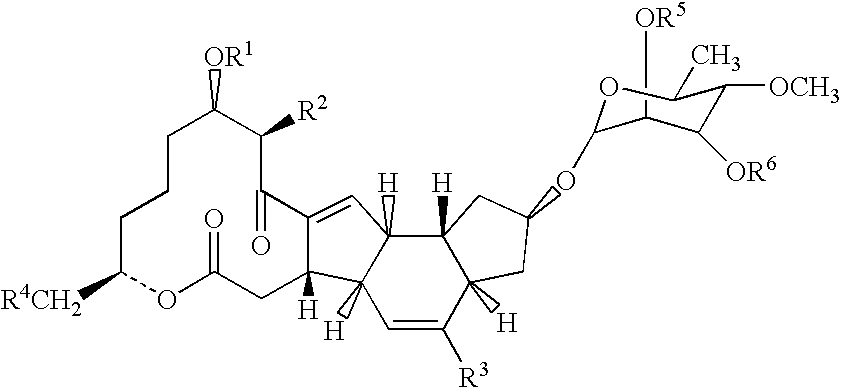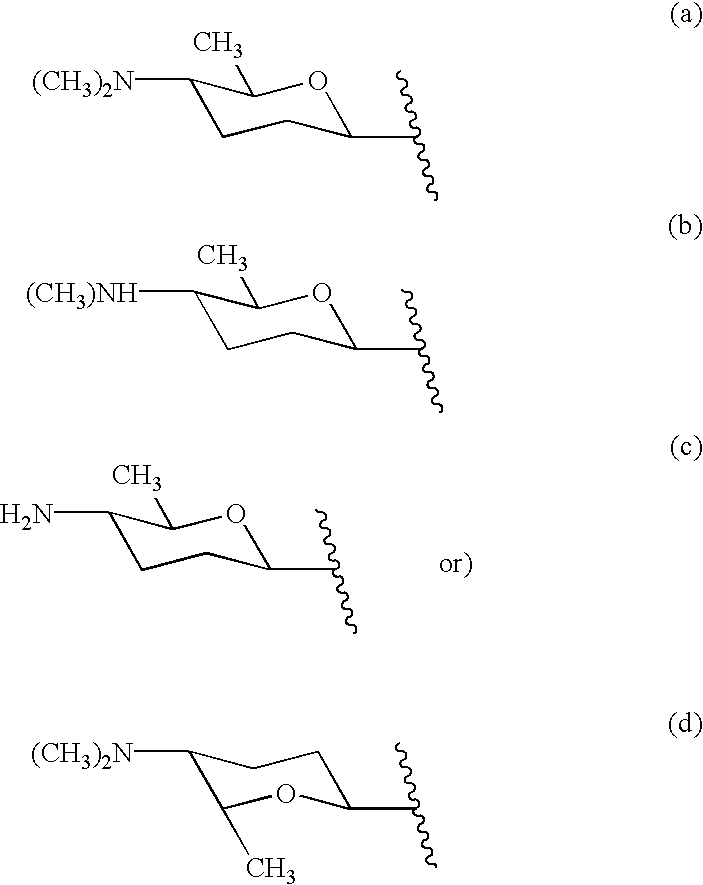Synergistic formulations
a technology of formulations and synergistic ingredients, applied in the field of synergistic formulations, can solve the problems of economic loss, huge agricultural losses worldwide, and the greatest damage to domestic animals and crops, and achieve the effect of reducing environmental contamination and efficacy
- Summary
- Abstract
- Description
- Claims
- Application Information
AI Technical Summary
Benefits of technology
Problems solved by technology
Method used
Image
Examples
example 1
[0119] In-vitro Investigation for Possible Potentiation Between Spinosad and Ivermectin in Sheep Blowfly Larvae.
[0120] Materials and Methods
[0121] Forty to 50 newly hatched 1.sup.st instar larvae of Lucilia cuprina were washed with sheep serum onto chromatography papers treated with serial dilutions of ivermectin or spinosad as set out below. After 48 hours numbers of live and dead larvae were counted. The LC90 was calculated for spinosad and ivermectin. Larvae were exposed to that concentration of spinosad or ivermectin and 1 / 2, 1 / 4 and 1 / 8 of the LC90. In addition larvae were exposed to 1:1, 1:4, 4:1, 9:1 and 1:9 combinations of each chemical with each concentration of chemical being a fraction of the LC90.
[0122] There were 19 treatment groups in the study (plus an untreated control group):
[0123] A 1-4: Ivermectin alone at rates of 1.times., 0.5.times., 0.25.times. and 0.125.times.LC90
[0124] B 5-8: Spinosad alone at rates of 1.times., 0.5.times., 0.25.times. and 0.125.times.LC90
[0...
example 2
In-Vitro Investigation for Possible Potentiation Between Spinosad and Ivermectin in Sheep Blowfly Larvae--Part II.
[0135] Materials and Methods
[0136] Solutions of spinosad, ivermectin, spinosad:ivernectin (1:1, 4:1 and 9:1) were prepared, serially diluted to concentrations expected to give from 0 to 100% mortality of blowfly larvae and used to treat chromatography papers. Forty or 50 newly hatched 1.sup.st instar larvae of Lucilia cuprina were washed on to treated chromatography papers with fortified sheep serum. After 48 hours numbers of live and dead larvae were counted.
[0137] The data was assessed in 2 ways
[0138] 1. Mortality was corrected for control mortality and analysed by Probit regresssion. LC50s were calculated and used to generate co-toxicity coefficients (Sun and Johnson, 1960 Analysis of joint action of insecticides against House flies. J Econ Entomol 53:887-892.).
[0139] 2. Estimates of effective sample sizes were calculated using the method for the Wadley problem in Gen...
example 3
Pour-On Formulation
[0145]
3 Ingredients g / L Spinosad 20 Ivermectin 5 antioxidant such as BHT 0.5 Crodamol IPM 15 Crodamol OSU 15 Crodamol OP to 100%
[0146] The formulation is applied to the dorsal midline of animals from the poll to the base of the tail using an applicator, usually a self filling dosing gun with a nozzle to dispense a narrow or wide band or lines of formulation along the back. The formulation is applied at 0.2 mL per kilogram body weight. Alternatively a set volume is applied to each bodyweight class--eg for sheep 10 mL for animals less than 30 kg, 15 for animals 31-50 kg and 20 ml for animals 51+kg. Sheep and other fibre producing animals should be treated within 24 hours of shearing or fibre collection.
PUM
| Property | Measurement | Unit |
|---|---|---|
| concentration | aaaaa | aaaaa |
| concentration | aaaaa | aaaaa |
| concentration | aaaaa | aaaaa |
Abstract
Description
Claims
Application Information
 Login to View More
Login to View More - R&D
- Intellectual Property
- Life Sciences
- Materials
- Tech Scout
- Unparalleled Data Quality
- Higher Quality Content
- 60% Fewer Hallucinations
Browse by: Latest US Patents, China's latest patents, Technical Efficacy Thesaurus, Application Domain, Technology Topic, Popular Technical Reports.
© 2025 PatSnap. All rights reserved.Legal|Privacy policy|Modern Slavery Act Transparency Statement|Sitemap|About US| Contact US: help@patsnap.com


